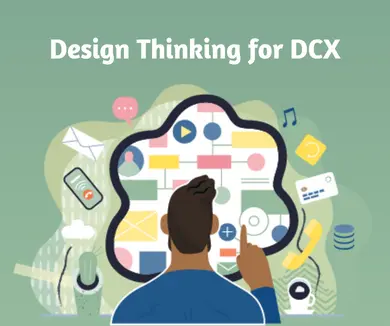Introduction
In today’s business world, companies place customers at the heart of their focus, prioritizing their needs over technology when designing products and services.
As consumers, all we really want when encountering a problem with a product or service is a quick and efficient solution. We expect businesses to value our time, understand our situation, and effectively resolve our issues, so we can smoothly carry on with our tasks.
According to Forrester Research, design thinking involves a set of practices that help teams form a stronger connection with customer experiences. It encourages a shift from traditional problem-solving to more innovative experimentation. However, at its core, design thinking revolves around creating products and services that truly captivate customers, making them essential throughout the product development process.
How do companies incorporate the customer's perspective into design thinking?
In design thinking, companies take a customer-centric or user-centric and problem-solving approach to design their products or shape their services. A great example of this is the story of Airbnb. At first, they were making only about $200 a week. But the founders noticed an important problem: the low-quality pictures posted by hosts were turning potential customers away from renting rooms.
To truly understand their customers, the founders traveled to different places and imagined what users wanted in a temporary place to stay. Their solution came from this deep understanding. They decided to invest in a high-quality camera and take pictures matching customers’ expectations based on their travel experiences. They showcased every room, highlighted special features like hot tubs or pools, and emphasized the appealing aspects of the neighborhood or nearby areas.
Have you ever wondered why some companies with small R&D budgets outshine their competitors? The answer is design thinking. It’s a powerful approach that lets them create products and services that connect with users on an emotional and aesthetic level, going beyond just form and functionality.
Stages of Design Thinking:
Clarify: In this phase, you need to observe the situation without being biased. It involves putting yourself in the shoes of the people affected by the problem and understanding their difficulties. You can ask them questions and listen carefully to their answers. The goal is to identify what needs to be addressed. Once you understand the problem better, you can create a problem statement or question to guide the rest of the design thinking process.
Ideate: Now it is time to generate ideas for potential solutions. Take the problem statement or question you formulated in the previous phase and start brainstorming. Use the patterns or observations you collected during the clarification phase as inspiration. During this stage, feel free to let your imagination and creativity soar as you explore different possibilities and think outside the box.
Develop: Next, you will develop potential solutions using the ideas you generated. Test and experiment with these solutions to determine their effectiveness. It is important to be prepared to iterate and make improvements based on your testing results. In design thinking, it is common—and actually encouraged—to revisit the ideation or clarification stages based on what you learn during the testing phase. Embracing this iterative approach allows for continuous improvement and refinement of your solutions.
Implement: Finally, it is time to implement the solution you have developed. However, it is important to note that you may need to take a few steps back and iterate on your final solution, as it is a crucial part of this phase. Through several rounds of testing, editing, and refining, you will arrive at a solution that can produce positive results. Remember, embracing the iterative nature of design thinking allows for continuous improvement and ensures the best possible outcome.
How Businesses Can Implement Design Thinking into Their Business Model?
Think About the Big Picture: Taking a step back and reflecting on how each company approaches their customer base’s perspective is crucial. It allows us to delve deeper into their strategies and understand how they recognized the need to employ empathy in specific situations. By considering these aspects, we can gain valuable insights and learn from their experiences.
Think Through Different Perspectives: Thinking through alternative solutions is highly beneficial, especially when examining the examples mentioned earlier. Take a moment to ponder each company’s problems and explore different approaches they could have taken. By doing so, you can enhance your ability to practice both empathy and creative ideation.
Nurture a User-Centric Mindset: If businesses don’t prioritize their customers, they won’t succeed in the long run. It’s as simple as that. When you think about your customers’ needs and feelings, you can better understand their problems and relate to their situations. This helps you come up with solutions that address their choices, needs, and preferences. By putting your customers first, you can take a problem-solving approach and increase your chances of success.
Embrace Failure as a Learning Opportunity: Throughout the process of design thinking, it’s possible to encounter obstacles or reach a point where starting over becomes necessary. It’s important to recognize that failure is a natural part of life and not let it discourage you. Instead, we should view failure as a chance for growth and progress. As a business, fostering a culture that embraces failure as an opportunity for learning and development is crucial. By doing so, you create an environment that encourages innovation and resilience.
Applying Design Thinking to Enhance DCX
Redefining Interaction: Enhancing Utility and Usability in DCX
When it comes to digital customer experience, one must consistently prioritize the objective of making interactions truly valuable. Irrespective of the nature of the interaction being designed, users are unlikely to engage with something that fails to deliver substantial benefits actively.
Embracing Empathetic Design Thinking: Unveiling Customers’ Mindsets
To truly cater to your customer’s needs, it is essential to adopt empathetic design thinking. This approach enables your business to comprehend the mindset of your customers and devise optimal solutions accordingly. In other words, it allows you to perceive problems through the lens of people’s challenges rather than relying solely on your own abilities and beliefs.
Placing Customer First: Cultivating Empathy for Enhanced DCX
Empathy has long been the differentiating factor for successful businesses. When it comes to DCX, empathy boils down to viewing customer service through the lens of your customers rather than solely focusing on your own perspective. Unfortunately, many businesses overlook this crucial aspect. By investing in customer journey research, you can uncover valuable insights and identify areas for improvement. Let empathy, not just profit, be the guiding force behind your decision-making process.
Crafting a User-Friendly Experience: Key Consideration in Design Thinking
In design thinking, one of the foremost priorities is to create a highly user-friendly experience. This entails meticulous deliberation on how tasks can be efficiently handled and simplifying processes to make them as effortless as possible. By ensuring seamless usability, we enhance the overall user experience, prioritizing convenience and ease-of-use.
Adopting the Customer’s Perspective: Unlocking Insights through Design Thinking
Design thinking necessitates a shift in our mindset towards the customer’s perspective. By embracing the customer’s point of view, we gain a deeper understanding of the areas that require improvement. We perceive problems as customers encounter them and envision solutions that align with their expectations. This customer-centric approach enables us to uncover valuable insights and create a customer experience that truly resonates with their needs and desires.
Nurturing Fresh Perspectives: Design Thinking for Problem Exploration
Design thinking empowers teams and organizations to break free from conventional assumptions and expectations, encouraging them to explore problems from innovative angles. Designing customer experiences without being bound by current limitations makes it possible to genuinely empathize with end-users and create products and services that prioritize their needs. This approach avoids the pitfalls of designing problems based solely on existing organizational structures, allowing for a truly user-centered approach to problem-solving and innovation.
Shattering Outdated Assumptions: Empowering Solutions through Design Thinking
Design thinking is a powerful tool for businesses to shed outdated assumptions about customer desires and needs, enabling superior problem-solving solutions. In today’s landscape, consumers anticipate personalized advice and services tailored to their unique requirements. By deeply understanding your client’s motivations, you can deliver a more personalized experience that addresses their specific needs. Embracing design thinking empowers businesses to embrace this customer-centric approach, ensuring that solutions are relevant and highly customized.
Conclusion
With its customer-centric and problem-solving approach, design thinking has emerged as a powerful methodology for businesses to create products and services that resonate with their customers. By incorporating the customer’s perspective throughout the design process, companies can establish emotional and aesthetic connections, surpassing mere form and functionality. The stages of design thinking, including clarification, ideation, development, and implementation, provide a systematic framework for generating innovative solutions. In conclusion, design thinking places the customer at the center of product and service design, enabling businesses to create meaningful and impactful experiences. By embracing this customer-centric approach, companies can foster innovation, build stronger connections with their customers, and gain a competitive edge in the market.



